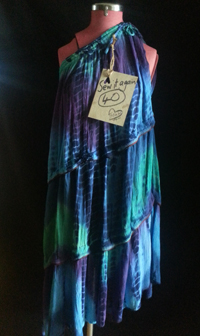 Skirt becomes one-shoulder dress by creating an armhole, lifting the hemline in a few minutes to create a second life.
Skirt becomes one-shoulder dress by creating an armhole, lifting the hemline in a few minutes to create a second life.
I’m refashioning a garment a day as a creative way to distil wardrobes of clothing horded or rescued from op shops because I appreciate their intrinsic value as natural resources.
For me this is not just about remaking and selling clothes at places like Reverse Emporium, it is about leading – demonstrating by actions – how simple old-fashioned home-sewing skills can empower us to dress in a different way.
My Sew it Again project emerged from postgraduate study with the Australian Rural Leadership Foundation through James Cook University which was transformative – it led to eco-leadership in an authentic space of my own making.
I’m tapping into a global sustainable fashion movement in the United Kingdom and United States which is raising awareness about where clothes come from and what is their true cost.
Professionals including Dr Kate Fletcher and Professor Sandy Black at the Centre for Sustainable Fashion in London and Sass Brown at the Fashion Institute of Technology in New York provide wings for new thinking. Journalists such Elizabeth L Cline in New York writing Overdressed: The shockingly high cost of cheap fashion, and Lucy Siegle in London To die for: Is fashion wearing out our world? provide insight.
Siegle says every year about 80 billion garments are produced worldwide. Textile production has doubled in the last thirty years. “In 1977 humankind demanded 31 million tonnes of fibre to keep us in flares, t-shirts and bed linen … but by 2007 this figure had risen to nearly 80 million tonnes which is 80 billion kilograms.”
Yarn does not magically appear, just as garments do not arrive fully formed. Siegle reflects on the annual impact: “The research suggests that each one of us is indirectly responsible for generating 0.6 kilograms of oil, 60 kilograms of water per kilogram and one kilogram of solid waste for every kilogram of fashion that we buy. With our yearly average of 55 kilograms of textiles, that makes 33 kilograms of oil, 3300 kilograms of water and 52 kilograms of waste in today – for every one of us.”
Definitely gives pause for thought. One comes to the view that we are being wasteful in our consumption and it’s high time to consider a more thrifty approach.
Home cooking skills are back in vogue now that we understand the high cost of fast food to personal health. Similarly, home sewing skills can help mitigate the high cost of fast fashion to ecological health – if we apply them to resewing clothing that already exists.
Sass Brown’s new book Refashioned: cutting-edge clothing from upcycled materials provides amazing inspiration as she documents creative reuse by designers. Just as there is ‘the cook and the chef’ in the food world, there is the ‘the designer and the refashioner’ in the clothing world.
Anyone can be the change they want to see in the world. Today’s offering is simple – just take a long skirt from your wardrobe or op shop that has a drawstring waist. Cut a slit of about 25cm, beginning just below the waistband. Try it on before neatening the opening using bias tape or hand stitching. Instant muumuu.

Well done with the recycle, reuse, refresh work you are doing, Jane
JoSe